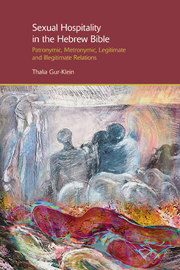 Sexual Hospitality in the Hebrew Bible
Sexual Hospitality in the Hebrew Bible In Reflections on the French Revolution, Edmund Burke (1729–97) epitomized the term ‘moral imagination’ as a store of ‘super-added ideas that the heart owns, and the understanding ratifies, necessary to cover the defects of our naked shivering nature’ (Burke [1909] 2001: 14, 28). ‘Moral imagination’ has become a common term employed in ethics, literary criticism and politics (see www.scholar.google.com). In my understanding, Burke's ‘moral imagination’ conjures our insight into the role we play in the life of others, understanding the harm and pain but also the redemption and reciprocity we may generate by our ability to conceive it by the power of the imagination.
Rounding up five years of research on forms of marriage and family relations, the story of Ruth has led me to conclude that what determines people's actions and relationships are choices, reciprocity and ‘moral imagination’, while their lives are entrenched in socio-economic factors. While the story of Ruth extols the value of kinship, customs and laws, ‘moral imagination’ is conceived in the protagonists' ability to manoeuvre between self-interest, imperatives, mores and customs; at the end of the day, going against the grain modifies customs and laws, interlacing the human factor. This motif connects Naomi and Ruth, who take a dubious course, with the story of Tamar, in which the laws of adultery demand death but the human factor eventually precipitates reconciliation.
To save this book to your Kindle, first ensure no-reply@cambridge.org is added to your Approved Personal Document E-mail List under your Personal Document Settings on the Manage Your Content and Devices page of your Amazon account. Then enter the ‘name’ part of your Kindle email address below. Find out more about saving to your Kindle.
Note you can select to save to either the @free.kindle.com or @kindle.com variations. ‘@free.kindle.com’ emails are free but can only be saved to your device when it is connected to wi-fi. ‘@kindle.com’ emails can be delivered even when you are not connected to wi-fi, but note that service fees apply.
Find out more about the Kindle Personal Document Service.
To save content items to your account, please confirm that you agree to abide by our usage policies. If this is the first time you use this feature, you will be asked to authorise Cambridge Core to connect with your account. Find out more about saving content to Dropbox.
To save content items to your account, please confirm that you agree to abide by our usage policies. If this is the first time you use this feature, you will be asked to authorise Cambridge Core to connect with your account. Find out more about saving content to Google Drive.